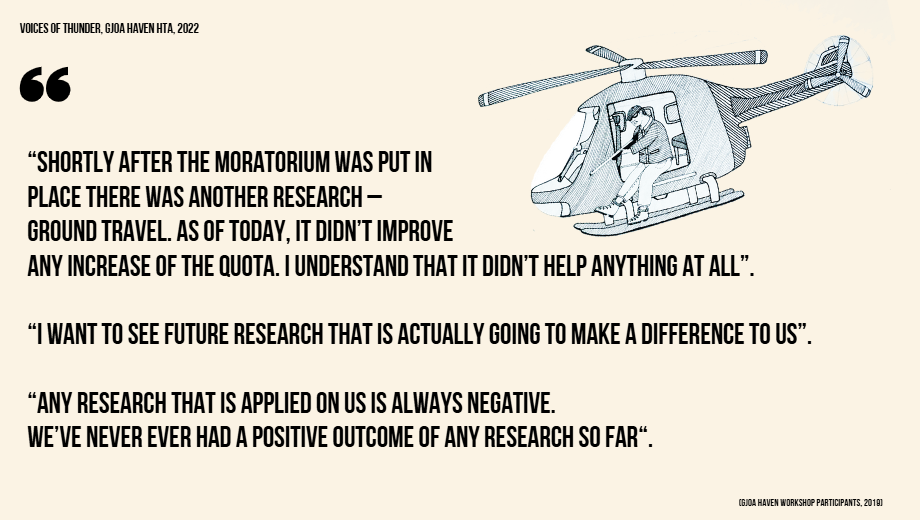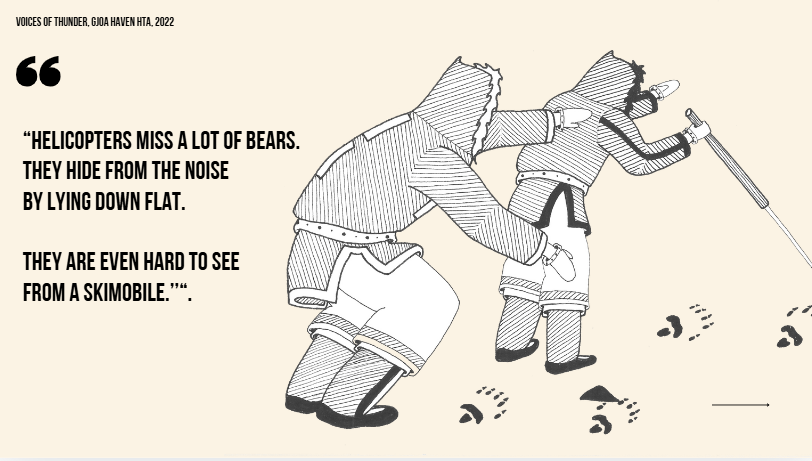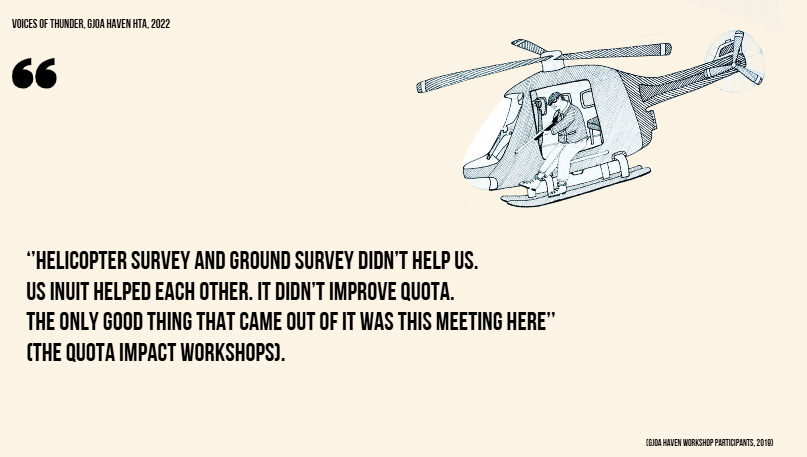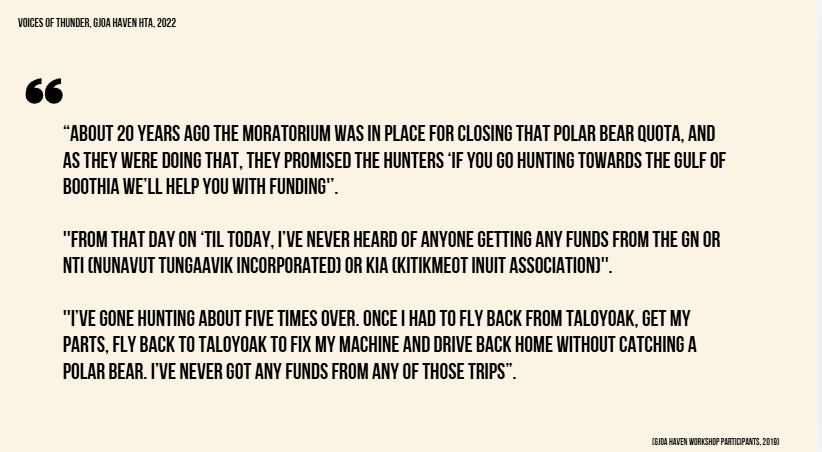Multiple Voices: Difference between revisions
No edit summary |
|||
| Line 2: | Line 2: | ||
During the remote calls we also navigated the position of the academic scientists when sharing such testimonies of quota reduction impacts. | During the remote calls we also navigated the position of the academic scientists when sharing such testimonies of quota reduction impacts. | ||
Our conversations included discussions on the challenge of presenting Gjoa Haven’s voices and objectives, without the academic partners speaking ''for'' the community | Our conversations included discussions on the challenge of presenting Gjoa Haven’s voices and objectives, without the academic partners speaking ''for'' the community. | ||
<div class="next_choice">You pass a '''"Landmark insight"''': “multiple sites of enunciation”. Take a closer look, to see how and why we have positioned the authors differently in each form of output. | <div class="next_choice">You pass a '''"Landmark insight"''': “multiple sites of enunciation”. Take a closer look, to see how and why we have positioned the authors differently in each form of output. | ||
Revision as of 15:35, 12 February 2025
Alongside the disruptive forces of Covid-19, we were able to remotely set a course to center Gjoa Haven's Voices of Thunder. We had decided on an academic article, multiple co-created audio/visual outputs, and one-pager communications.
During the remote calls we also navigated the position of the academic scientists when sharing such testimonies of quota reduction impacts. Our conversations included discussions on the challenge of presenting Gjoa Haven’s voices and objectives, without the academic partners speaking for the community.
Or,
Landmark: Multiple Sites of Enunciation
Testimonial Reading
For the academic article, I eventually suggested the academic research partners of the BearWatch project to conduct a "testimonial reading". This approach, proposed by Megan Boler[1]suggests for readers or listeners to accept testimony by considering themselves as implicated with the events they accept testimony for. ‘’…one must recognize oneself as implicated in the social forces that create the climate of obstacles the other must confront’’[2]
This approach resonates with the guiding principles for reconciliation put forward by the TRC (TRC, 2015 p. 113). One of those principles proposes an ‘awareness of the past, acknowledgement of the harm that has been inflicted, atonement for the causes, and action to change behaviour’ (ibid). In other words ‘The TRC (...) puts responsibility for change squarely on the shoulders of all Canadians’ (McGregor, 2018 p.823 emphasis mine)- not just the Indigenous people who take up responsibility for sharing their experiences publicly.
- ↑ Boler, M. (1997) “The risks of empathy: Interrogating multiculturalism’s gaze,” Cultural Studies, 11(2), pp. 253–273. Available at: https://doi.org/10.1080/09502389700490141.
- ↑ Boler, M. (1997 p.257) “The risks of empathy: Interrogating multiculturalism’s gaze,” Cultural Studies, 11(2), pp. 253–273. Available at: https://doi.org/10.1080/09502389700490141.
Voices of Thunder Testimonies
This cut will continue to trace the co-creative processes and the results that have emerged from the ongoing conversations between the Gjoa Haven HTA representatives and BW scientists, i) Voices of Thunder; an animated motion graphic documentary, ii) Winds of Change; webpage, and iii) Voices of Thunder; an interactive slideshow.
You are invited to engage with these outputs to the degree that feels fitting with your own positionality. Scientists that practice community-based wildlife monitoring in the Canadian Arctic will likely find some familiarities across their own research contexts. Others, on the other hand, may not have much to gain by conducting a testimonial reading alongside non-Inuit researchers, and would perhaps prefer to only engage with Gjoa Haven’s testimonies directly, by watching the animated graphic documentary and timeline, or exploring the "Winds of Change" website.
You also see a track that may lead you back to Cut 3. If you were redirected from this cut, earlier in your journey, this is your opportunity pick up your track across the unfolding of the BearWatch project.
Return to Cut 3: Wayfaring the BearWatch project
Voices of Thunder Animated Graphic Documentary
Voices of Thunder Inuktitut Syllabics version
Voices of Thunder English version
The experiences that are shared in this documentary come from the testimonies of 28 different community members, even though they are narrated through the "voice-over" of one speaker from the community: William Aglukkaq. To provide transparency on the multitude of voices that have informed the final film, all the community members that contributed to this narrative are named at the end of the video. The archival documentation and scientific literature that is referenced as particular institutional context, was collected by me, included in the script with agreement of the HTO, and then translated and narrated through the recorded voice-over of another speaker from the community: Tuppittia Qitsualik.
"Keep Going" to follow the Voices of Thunder, they will lead you to some of the other research outputs.
Or,
Take "Detour" to the film’s synopsis and its poster as it was distributed within the film festival circuit.
Or,
Take a "Detour to Cut 2"; Aesthetic Action, which allows you move alongside the process of film-making within the community.
Or,
"Return to Cut 3", if you trailed of while doing other fieldwork in Gjoa Haven.
Detour: Voices of Thunder "Synopsis"
Detour to Cut 2: Aesthetic Action
Return to Cut 3: Gjoa Haven fieldwork 2022
Winds of Change Webpage
The Gjoa Haven HTA board had expressed a desire to have its “Voices of Thunder, echo everywhere”. We responded to this desire by building a “Winds of Change” webpage, in addition to the motion graphic animation. The webpage functions as an online advocacy tool and repository for Gjoa Haven’s “Voices of Thunder”, as it also gathers much of the other collected material related to Gjoa Haven’s experiences around polar bears.
This webpage performs a political appeal for recognition as put forward by the HTA board in 2022. It is published in 3 versions: English, Inuktitut, and a Syllabics version.
Voices of Thunder Interactive Slideshow
During the co-production of the animated graphic documentary, it became clear that in addition to an academic publication, webpage and video production, a third way of presenting the experiences as shared by Gjoa Haven’s community members, might be desirable. A document that would provide all the same information, arts and experiences that were shared in the animated graphic documentary- but could also afford for a more responsive way of interacting with Gjoa Haven’s testimonies. A supplemental form of output to the video and webpage, was created in the form of interactive slides, available in three versions; English, Inuktitut, and Inuktitut syllabics. It was added to the Winds of Change webpage.
English Version Slideshow
Inuktitut Version Slideshow
Inuktitut Syllabics Version Slideshow
"Keep Going" to continue tracing our process of testimonial reading.
Alternatively, you can "Detour" straight to the ongoing developments around the Voices of Thunder as they keep unfolding, by taking a short-cut to the current cusp of emergence.
"Return to Cut 2": Aesthetic Action, if you only came here to view the "Voices of Thunder" audio-visual outputs
Detour to Cut 1: The Cusp of Emergence
Return to Cut 2: Aesthetic Action
Voices of Thunder Testimonial Reading
You have chosen to follow alongside the non-Indigenous researchers of the Bearwatch project as they, i) acknowledge their initial affective responses towards selected testimonies, ii) explore how they may be implicated with the experiences shared by Gjoa Haven community members, and iii) as they make themselves accountable, as part of a research legacy that has neglected to properly recognize and engage with these experiences before.
The following testimonial reading is explicitly written from the perspective of several academic scientists of the BearWatch project, in particular that of me and three of the BW Principal Investigators actively involved with the community-based fieldwork in Gjoa Haven.
Affective Responses
To refuse passive empathy as non-Indigenous researchers in the context of the settler-Indigenous reconciliation, we must explore self-implication and our potentials for taking reconciliatory action- while also acknowledging our affective responses (including those of guilt and unsettlement) to assist us in our processes of reconciliation, rather than hold us back.
What are your first affective responses to such commentaries on research?
Implication
Part of conducting a testimonial reading is to consider oneself as implicated within the larger structures ‘that create the climate of obstacles the other must confront’ (Boler, 1997, p. 257). This “climate” is what Karen Barad refers to as the agential ‘apparatus” (Barad, 2007 p.). And what Rothberg understands as emerging from collectives, like for example the academic institute or the settler-state, to which one subscribes and in turn becomes implicated with (Rothberg, 2019).
Researchers of the Bearwatch project were initially hesitant to enter this conversation. The topic of quota setting was considered as outside of their sphere of influence, and scope of scientific research objectives.
This testimonial reading made it possible to acknowledge and recognize our responsibility towards our research partners to listen and engage with their needs and priorities.
Following Rothberg, we are not by default guilty of the lack of accountability displayed by previous research partners in Gjoa Haven - but we do carry a responsibility to acknowledge and address the structures and institutes that have made, and continue to make it possible for researchers to avoid accountability and ignore community priorities.
Or,
Wrecksite: Nunavut Polar Bear Monitoring and Management
Response-ability
To be responsible, is to enact your ability to respond. Rothberg invokes an implicated subject that assumes responsibility based on collective legacy, but that also has individual agency in terms of resisting or contributing to contemporary structures of injustice. ‘One has responsibility always now’ (Young, 2010).
As academic, non-government researchers collaborating with the community of Gjoa Haven, we also engaged with the need for broader recognition of Inuit knowledge in the form of better integration of Inuit Qaujimajatuqangit in polar bear research and management by critically exploring our own practices when it comes to knowledge conciliation.
"Keep Going" to stay with the questions of response-ability and accountability.
Or,
Detour: Knowledge Co-production in BearWatch
Relational Accountability
Within Indigenous (research) paradigms of collective responsibility, and intra-dependency- accountability is often understood in terms of recognizing one’s responsibilities and making oneself accountable to ones more-than-human relations[1][2][3]. Traditional understandings of accountability within western academia as the occasional ‘presenting back’ final outcomes of research to partnering communities, come across as distant and disengaged in comparison.
In the case of Gjoa Haven, many community members expressed feeling like they had to fend for themselves after the considerable cut in polar bear quota. And that the support they were promised, was never delivered.
Pay attention to this "Landmark" insight.
Or,
- ↑ Wilson, S. (2018). Research is ceremony: Indigenous research methods: Fernwood Publishing.
- ↑ McGregor, D. (2009). “Honouring Our Relations: An Anishnaabe Perspective on Environmental Justice.” In Speaking for Ourselves: Environmental Justice in Canada, ed. Julian Agyeman, Peter Cole, Randolph Haluza-Delay, and Pat O’Riley, 27–41. Vancouver: University of British Columbia Press.
- ↑ Kovach, M. (2009). Indigenous methodologies: Characteristics, conversations, and contexts. University of Toronto press.
Landmark: Listening and Witnessing
Another Point of Beginning
You have reached "Another Point of Beginning". These are not conclusive endings to my research, but rather perform at the cusp of emergence: They are a story so-far. Some of these points mark the end of funding cycles or project activities. Or they mark the limitations and scope of this particular PhD dissertation. Others are trails, and tracks that have faded out, as they remained un-revisited. They however always mark one moment along an ongoing animate line of correspondence between multiple agencies, and they always allow for continuing another cut.
This is where we take account for our journey so far. This journey is always partial, and so are the insights we have built on our way. You can trace the path you have taken through this Knowledge-Land-Scape by clicking the "trace" bar in the upper left corner of your screen. It will allow you to account for some of the insights that your journey has given you. The map below shows you the full extent of wayfaring possibilities of the scape.
Cut 1 has taken you along the journey of what originally would have been an academic representation of Gjoa Haven’s experiences of the impacts of significant quota reductions, but unfolded as a co-creative process of accepting testimony between Gjoa Haven community members and academic researchers of the BearWatch project.
Beyond the Cut
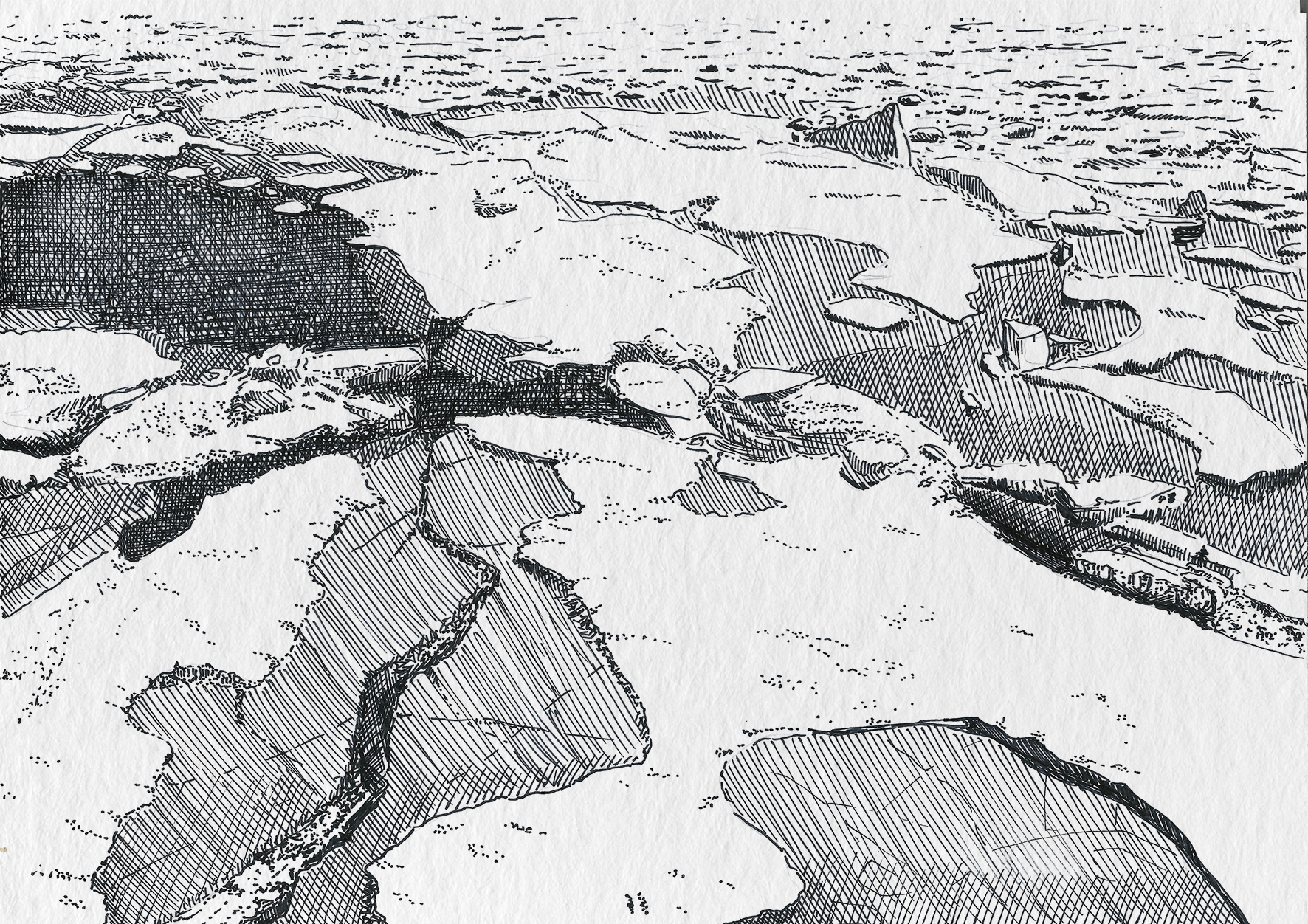
The “Voices of Thunder” Animated Graphic Documentary has been screened multiple times in Gjoa Haven, and shared on the Gjoa Haven community Facebook page, with the explicit call to share the movie and show it to friends and family within and outside of Gjoa Haven. It was also screened at several academic conferences related to the (Canadian) Arctic and wildlife management. Among them was a plenary screening at the Annual Science Meeting of ArcticNet in Toronto, 2022, and it was screened as an opening movie during Critical Arctic Studies conference in Rovaniemi, 2023. We furthermore circulated the movie in the film festival circuit, where it got accepted and screened at several relevant festivals like; Society for Visual Anthropology Film and Media Festival (SVAFMF) in Toronto, 2023, Aulajut: Nunavut International Film Festival in Iqaluit, 2023, Dawson City International Short Film Festival in Dawson, 2024 and the Available Light Film Festival in Yukon, 2024. Finally, it was taken up in the online collection of imagineNATIVE Film + Media Arts Festival in 2023.
The film was not only disseminated by BearWatch researchers. The HTA screened the movie at a regional meeting during which the HTA’s of Gjoa Haven, Taloyoak and Cambridge Bay met with the Kitikmeot Regional Wildlife Board. The film was received with praise from the regional board and the other two communities. A Member of the Legislative Assembly, who resides in Gjoa Haven, leveraged the film, together with the “Winds of Change” website in a letter to the Minister of Environment to call attention to Gjoa Haven testimonies and request ‘a detailed update’ on the ‘department’s work with the Gjoa Haven Hunters and Trappers Association to manage this subpopulation’.
As for this cut and its testimonial reading, we invite audience members to engage with Gjoa Haven appeals in ways that feel appropriate to ones reconciliatory responsibilities. We nevertheless hope to inspire our academic audience(s), especially those researching wildlife in Nunavut (and beyond), to recognize themselves as structurally implicated in the structures that have contributed to the experiences to which the testimonies in this manuscript speak, and explore how such structures manifest in their own research context.
Our article, Voices of Thunder: Polar Bear Quota Reduction Impacts in Gjoa Haven, Nunavut - From Purveying Voices to Accepting Testimony, was submitted for peer review at the Arctic Science Journal in January 2025.
"Detour to Cut 2" to understand more about wayfaring as a process of ethical engagement.
"Detour to Cut 3" to understand more about how aesthetic action may co-constitute ethical space.Detour to Cut 2: Aesthetic Action point of Beginning
Detour to Cut 3: Wayfaring the BW project Point of Beginning

